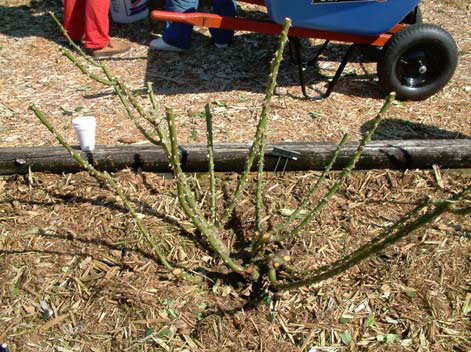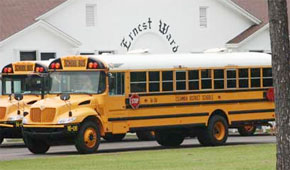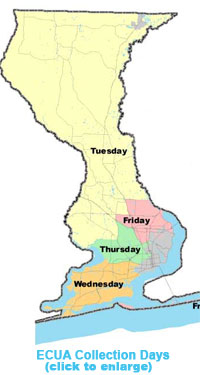Think Roses In February
February 12, 2011
 With Valentine’s Day just around the corner, out thoughts go to roses. Roses grown in Florida require regular maintenance, but growing roses can be a rewarding hobby for those who like to spend time in the garden each week. Pruning will help keep your plants healthy and productive.Hybrid tea and grandiflora roses, in particular, should be pruned every year during the first or second week in February. Otherwise, these roses tend to become leggy, less vigorous and unattractive, and they won’t bloom as well.
With Valentine’s Day just around the corner, out thoughts go to roses. Roses grown in Florida require regular maintenance, but growing roses can be a rewarding hobby for those who like to spend time in the garden each week. Pruning will help keep your plants healthy and productive.Hybrid tea and grandiflora roses, in particular, should be pruned every year during the first or second week in February. Otherwise, these roses tend to become leggy, less vigorous and unattractive, and they won’t bloom as well.
Other types of roses, such as floribunda, shrub and everblooming old garden roses, generally require less drastic pruning, but they still benefit from pruning to improve their shape or control their size, when necessary.
Following a logical sequence of steps while pruning will help make the job seem less complicated. The first step is to remove the three D’s: any dead, diseased or damaged wood. Cut the stems one inch below darkened areas, making sure you are cutting back to green wood. Make the cut at a 45 degree angle about ¼‐inch above an outward facing bud. If no live buds remain, remove the entire cane. Weak, spindly canes, which are the diameter of a pencil or less, should also be removed the same way.
 To avoid dieback and encourage rapid healing, pruning cuts should be made just above a dormant bud (eye). When an entire branch is removed, make a smooth cut at the point of juncture.
To avoid dieback and encourage rapid healing, pruning cuts should be made just above a dormant bud (eye). When an entire branch is removed, make a smooth cut at the point of juncture.
The second step is to remove branches that grow toward the center of the plant. This opens up the plant for better air circulation and allows sunlight to penetrate the inner portion of the plant. The third step is to locate crossing branches and remove the weakest one. Crossing branches may rub against each other, causing abrasions that may serve as openings for disease organisms to enter the plant. Also remove sucker growth, which is growth coming from below the bud union. Sucker growth can be from the root stock and a different rose variety; if not removed, sucker growth will crowd out the desired variety
Finally, prune to shape the plant. Hybrid teas, grandifloras and floribundas can be pruned 12 to 24 inches in height, leaving up to four to eight large, healthy canes the diameter of your finger or larger. Shrub and species roses should be pruned lightly, removing no more than 1/3 of the growth. Miniature roses need only minimal pruning. Old‐fashioned roses and climbers that bloom only once a year should be pruned
 Immediately after flowering. Do not prune these types of roses heavily in the early spring since they bloom on wood from the previous year’s growth. If you have purchased new rose bushes you don’t have to worry about pruning them. Newly purchased roses have already been pruned, and no further pruning is required.
Immediately after flowering. Do not prune these types of roses heavily in the early spring since they bloom on wood from the previous year’s growth. If you have purchased new rose bushes you don’t have to worry about pruning them. Newly purchased roses have already been pruned, and no further pruning is required.
Pruning back roses takes some getting used to. Many new gardeners have a hard time getting up the nerve to cut their bushes back. If you don’t, however, the result will be tall, rangy, overgrown bushes that will not be nearly as attractive.
Theresa Friday is the Residential Horticulture Extension Agent for Santa Rosa County.
Officials: Gas-Like Smell Was Normal
February 11, 2011
Several people around Flomaton and North Escambia reported a gas-like smell Friday night, including a report in which Century Station of Escambia Fire Rescue responded to a gas leak on Highway 168 west of Century.
Officials said the gas-like smells around Flomaton and south into North Escambia were from the gas and oil facilities in Escambia County, Ala. Officials said the smell was nothing dangerous or out of the ordinary; the smell was just being pulled south with the light northerly wind flow.
‘Major Malfunction’ Leaves Thousands Without Power
February 11, 2011
Thousands of people in the eastern half of Escambia County, Ala. lost power Friday night after a “major malfunction” at a primary electrical substation — and they remained in the dark well into the early morning hours Saturday.
 The incident happened at a Southern Pine Electric Cooperative main power substation just outside Brewton before 7 p.m. Friday. NorthEscambia.com received numerous reports that the “explosion” or a bright glow could be seen in the night sky from as far away as Jay, Century, Flomaton, McDavid and Walnut Hill.
The incident happened at a Southern Pine Electric Cooperative main power substation just outside Brewton before 7 p.m. Friday. NorthEscambia.com received numerous reports that the “explosion” or a bright glow could be seen in the night sky from as far away as Jay, Century, Flomaton, McDavid and Walnut Hill.
Escambia County (Ala.) Director David Adams said about 5,000 Southern Pine customers lost power during what he termed a “major malfunction” at the power substation.
Power was restored for all customers after 4 a.m. as temporary equipment — essentially a portable substation — was transported to the scene from Power South in Andalusia, Ala., and installed.
The outage includes thousands of Southern Pine customers outside of Brewton and Flomaton — both cities are served by Alabama Power.
The incident was believed to have been the result of a small animal that wandered into the facility and created a short.
Three Injured In Molino Road, Highway 29 Crash
February 11, 2011
Three people were injured in a wreck involving a car and a semi-truck Friday night in Molino.
According to the Florida Highway Patrol, the driver of a Toyota Camry, Bridgette McMillian, 33, of Monroeville, Ala., was injured, along with two juvenile passengers ages 16 and 14. Two other passengers — Michael McMillian, 27, and Jeffrey McMillian, 29, both of Monroeville — were not injured. The injuries were not believed to be life threatening.
Their southbound vehicle was struck by a semi-tractor with no trailer being driven by Terry Spears, 54, of Molino, according to the FHP. Spears and his passenger, Joshua Spears, 29, were not injured.
According to the FHP. Spears pulled out of Molino Road directly into the path of McMillian’s car. Spears was cited for violation of right of way, and McMillian was cited for failure to provide proof of insurance, according to the FHP.
The Molino Station of Escambia Fire Rescue and Escambia County EMS also responded to the crash.
Pictured above: Three of five people in this car were injured in a crash with a semi-truck Friday night in Molino. NorthEscambia.com photo, click to enlarge.
Art Club To Host Barnes & Noble Book Fair
February 11, 2011
The Northview High School Art Club will be hosting a book fair Saturday at the Barnes & Noble book store in Pensacola to raise money for the visual arts program.
Ten percent of any purchase made at the store — whether it be beverages, food, books or music — will be donated to the school’s art program to purchase much-needed art supplies. To help, just mention Northview Arts or present a voucher (available in store) at the time of purchase.
Students will be face-painting for free and displaying art work at the store from 10 a.m. to 2 p.m tomorrow. Residents are urged to come out and support the arts in our community.
Additionally, 10 percent of any online purchases made this weekend will also be credited to the school’s art program; just use book fair ID#10422343
Two New Career Academies Planned For Ernest Ward Middle
February 11, 2011
Two new career academies are planned for Ernest Ward Middle School for the next school year.
 A graphic arts academy and a culinary arts academy for Ernest Ward are both set for approval later this month by the Escambia County School Board. The new academies will be in addition to an electrical academy that is currently in its first year at the school.
A graphic arts academy and a culinary arts academy for Ernest Ward are both set for approval later this month by the Escambia County School Board. The new academies will be in addition to an electrical academy that is currently in its first year at the school.
Middle school career academies are small, personalized learning communities within a school in which select students and teachers participate during a two or three-year span. A career academy involves teachers from different subjects working together as an interdisciplinary team.
The Ernest Ward Middle School Graphic Arts Academy will focus on digital and web publishing, graphic design and multimedia production. Students will be able to continue their education in career academies at Northview, Tate, Pine Forest, Escambia or West Florida high schools. Students will also be able to earn high school credits while in middle school.
The academy will use software such as Microsoft Office and the Adobe Digital School Collection, including Photoshop Elements and Premier Pro Elements.
The lead instructor for the academy will be Brenda Rutherford.
The Ernest Ward Middle School Culinary Arts Academy will include topics such as creative food presentation, nutrition and wellness, personal health and kitchen design. Students will be able to continue their education with academies at Pine Forest, Washington and Escambia high school. While Northview High School does not offer a culinary-related academy, students that attend NHS will be able to take nutrition and wellness and principles of food preparation courses.
Students will produce a green kitchen design, produce an edible display, design and decorate cakes for a contest and more. Students will have the opportunity to obtain the “Safe Staff” industry certification while in middle school. An agreement with Pensacola State College will allow students entering PSC with ServSafe Certification to be awarded six college credits.
The lead instructor for the academy will be Kathy Ellis.
Get Your Trash Out Earlier; ECUA Changes Route Times
February 11, 2011
 Beginning Tuesday, you’ll need to have your trash out earlier to make sure you don’t miss your pickup if you are an ECUA customer.
Beginning Tuesday, you’ll need to have your trash out earlier to make sure you don’t miss your pickup if you are an ECUA customer.
ECUA’s Sanitation Department will implement new collection routes for garbage, recycling and yard trash service on Tuesday, February 15. The changes will only affect the time of collection, while all collection days will remain as scheduled. To avoid a missed pickup, ECUA customers are asked to place their garbage and recycling containers, as well as any yard trash, at the curb by 5:30 a.m. on their normal collection day.
“The popularity of the ECUA Curbside Recycling program is reflected in the steadily increasing amount of recyclables and decreasing amount of garbage and yard trash being collected weekly,” said Nathalie Bowers, public information officer for ECUA. “A periodic review and adjustment in collection routes and schedules allow us to better serve our customers and operate in a more efficient and cost-effective way.”
For more information, or to learn about ECUA’s recycling program visit ecua.org or call (850) 476-0480.
Quintette Road To Be Resurfaced In Santa Rosa
February 11, 2011
Thursday, the Santa Rosa County Commission unanimously approved a $1.28 million project to resurface Quintette Road on the Santa Rosa County side of the Escambia River.
Santa Rosa County is entering into an agreement with the Florida Department of Transportation for the milling and resurfacing of Quintette Road from the Escambia River Bridge to Chumuckla Highway. The bottom line for the project is $1,275,655 — with 75 percent from the Florida Department of Transportation and 25 percent from the Electric Franchise Fee Road and Bridge Reserve fund.
Work is expected to begin on the project in April, and it should take about two months to complete, according to Joy Tsubooka, public information officer for Santa Rosa County.
Quintette Road runs from Highway 29 in Escambia County to Chumuckla Highway in Santa Rosa County. It is the only roadway across the Escambia River between Highway 4 in Century and Highway 90 in Pensacola.
Florida Teacher Merit Pay Bill Advances
February 11, 2011
A Senate committee gave the first yes vote Thursday to a new merit pay bill setting out how teachers would be paid.
The vote came without the angry protests of last year’s effort.
One of the differences with this year’s move to make classroom teachers more accountable for quality education in the state has been that those teachers have been more involved, although there are still many with deep concerns – and questions – about how they’ll be evaluated if the measure becomes law.
One of the major sources of concern for teachers isn’t what’s in the bill (SB 736) that was unanimously approved in its first committee stop Thursday – it’s what’s not in the bill.
The measure calls for an evaluation process to be set up for teachers, but doesn’t spell out the details, leaving it up to the Commissioner of Education and local school districts – in consultation with a panel including representatives of school boards, superintendents and the state teacher union – to work out just how teachers would be evaluated.
 The teacher union, the Florida Education Association, opposes the bill, though its leaders say they appreciate being asked to help work out the details. One of the main reasons the union is still against it is the uncertainty about just what it is that may get a teacher fired in the future.
The teacher union, the Florida Education Association, opposes the bill, though its leaders say they appreciate being asked to help work out the details. One of the main reasons the union is still against it is the uncertainty about just what it is that may get a teacher fired in the future.
“You’re asking all of us to put all our professional careers on the line for something that hasn’t even been developed yet,” Andy Ford, president of the FEA, told the Senate Education Pre-K-12 Committee on Thursday, saying that the bill is “very troubling to teachers.”
Still, it’s a calmer and more collaborative start than last year, when a measure eliminating teacher tenure and directly linking teacher pay to the standardized test performance of students emerged quietly during the legislative session and was passed despite heavy protests from educators, who said then they felt shut out of the process. It was vetoed by then-Gov. Charlie Crist, who is no longer in office.
“It has been much different,” acknowledged Ford, speaking to this year’s bill sponsor, Republican Sen. Steve Wise, a congenial and results-oriented legislator who doesn’t appear to be bent on fighting the teacher’s union – typically a bastion of support for Democrats – for political reasons. That was an accusation leveled against last year’s backers of the bill. “You have given people an opportunity to at least express their concerns.”
Wise, who patiently listened to testimony from teachers for two days this week, also noted the difference as the committee prepared to vote hours before it was scheduled to because there wasn’t anyone left who wanted to complain about the proposal.
“It is not Senate Bill 6,” Wise said, referring to last year’s measure. “It’s Senate Bill 736.”
Wise also promised the union and teachers who spoke to his committee on Thursday that he’ll continue to listen to them and to work on improving the bill.
“We don’t have all the answers,” Wise admitted.
Wise made that remark after listening to some concerns from Jennifer Barnhill, a teacher who works with disabled and emotionally and behaviorally disturbed students, who said she worried that an evaluation mechanism, when it is eventually decided on, could hurt deeply caring teachers who need longer to see gains in learning than the politicians might want to give them. One of her students just this month was committed, because he stopped taking his medication for bipolar disorder. She needs more time to see learning gains in such students, she said.
“A good day for me is when I don’t get cursed out, and desks don’t go flying across the room,” said Barnhill who teaches at an alternative school in Tallahassee. “These are my realities every day.”
She’s not complaining – “I could not teach another population … I’ve found my calling,” Barnhill said. But, teachers of those types of students can’t be measured the same as teachers of more mainsteam students because learning may be slower in that environment, she said.
That prospect makes finding a way to evaluate teachers difficult, Wise acknowledges.
“I think this perplexes all of us,” he said. That’s part of the reason he wants a long look at how teachers will be evaluated, even if it means the bill may pass without spelling it out.
But the unknown is the stumbling block for many teachers.
The bill doesn’t end tenure for current teachers – as last year’s bill would have done.
Current teachers are grandfathered into the system they were hired under – they may be able to keep their current long-term contracts, though they’ll still have to be evaluated under the system that is eventually developed, and could lose their jobs if their students don’t perform well on standardized tests.
New teachers, those hired starting in July, would be on one-year contracts, subject to annual review starting in 2014.
In the meantime, teachers will also have to be evaluated under a new, parallel program that was set up as part of the Race to the Top grant program, under which the state won a large pot of money from federal officials.
The committee earlier this week heard from Michelle Rhee, something of a celebrity in conservative school reform circles. The former District of Columbia schools chief won plaudits for firing teachers deemed ineffective and taking a hard line toward under-performing schools.
The union’s Ford urged lawmakers not to fall in line with “reformers” who simply blame teachers for all education woes – particularly if the state doesn’t find ways to help them get better.
“Florida cannot fire its way to excellence,” Ford said. Looking to Rhee for guidance was particularly irksome.
“Washington, D.C. is at the bottom of the Quality Counts report,” he said, referring to an Education Week report that recently was touted by some state officials and legislators for giving Florida high marks.
“Florida is No. 5,” Ford noted. “I don’t know why we’re looking at Washington, D.C. as a model for anything.”
The Senate bill now goes to the education budget committee, where it’s on the agenda for next Tuesday. So far, there is no comparable bill in the House.
By David Royse
The News Service Florida
Short Lines As Verizon’s iPhone 4 Goes On Sale Locally
February 11, 2011
The much anticipated iPhone 4 debuted on the Verizon Wireless network on Thursday, with few customers lining up to be the first to get the smartphone.
“I just wanted to be one of the first ones because I’ve been waiting for a while for Verizon to get them,” said Lauren Cloud, a senior at Northview High School. She held ticket number two for the second iPhone sold at the Verizon store in Atmore (although she says she was the first to seal the deal and make it out the door).
For Cloud, it was a major upgrade from her old Droid Eris.
“I absolutely love it,” she said a few hours after moving from her old Google Android phone. Until Thursday, the iPhone 4 was available locally only on the AT&T network, which has somewhat spotty coverage in the North Escambia area.
 Customers across the U.S. braved inclement weather, lines or both at stores across the country to be among the first to purchase an iPhone 4 on the Verizon Wireless network. In Atmore, Cloud said there was a not a large crowd waiting for the phone when the doors of the store opened, but about eight people came in behind her.
Customers across the U.S. braved inclement weather, lines or both at stores across the country to be among the first to purchase an iPhone 4 on the Verizon Wireless network. In Atmore, Cloud said there was a not a large crowd waiting for the phone when the doors of the store opened, but about eight people came in behind her.
“I absolutely love it!”, Cloud said.
The iPhone 4 is available for $199.99 for the 16 GB model and $299.99 for the 32 GB model with a new two-year customer agreement.
Pictured top: Verizon customers across the country snapped up the new iPhone 4 on Thursday. Pictured inset: Northview senior Lauren Cloud seen in this mirror self portrait with her new iPhone 4. Courtesy photos for NorthEscambia.com, click to enlarge.




